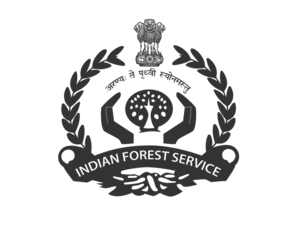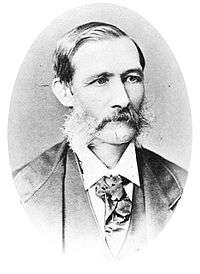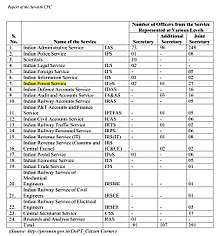Indian Forest Service
The Indian Forest Service (IFS)[2] is one of the three All India Services of the Government of India. The other two All India Services being the Indian Administrative Service (IAS) and the Indian Police Service (IPS).[3][4][5] It was constituted in the year 1966 under the All India Services Act, 1951, by the Government of India.
| Service Overview | |
 Motto: अरण्यः ते पृथ्वी स्योनमस्तु (Sanskrit) "The Forest is Earth's delight" | |
| Formerly known as | Imperial Forest Service (IFS) |
|---|---|
| Date of establishment | 1864 (as Imperial Forest Service) 1966 (as Indian Forest Service) |
| Country | India |
| Staff College | Indira Gandhi National Forest Academy (IGNFA), Dehradun, Uttarakhand |
| Cadre Controlling Authority | Ministry of Environment, Forests and Climate Change |
| Legal personality | Governmental: Government service |
| General nature | Administration of Forest and Wildlife resources |
| Cadre strength | 3131 (2182 Direct Recruits and 949 Promotion Posts) |
| Website | ifs |
| Service Chief | |
| Director General of Forests | Sanjay Kumar, IFS (1984 Batch, Jharkhand Cadre)[1] |
| Head of the All India Civil Services | |
| Cabinet Secretary | Rajiv Gauba, IAS |
The main mandate of the service is the implementation of the National Forest Policy[6] in order to ensure the ecological stability of the country through the protection and participatory sustainable management of natural resources. An IFS officer is wholly independent of the district administration and exercises administrative, judicial and financial powers in his own domain. Positions in state forest department, such as District/Divisional Forest Officer (DFO), Conservator of Forests (CF) , Chief Conservator of Forests (CCF) and Principal Chief Conservator of Forests (PCCF) etc., are held only by IFS officers. The highest ranking IFS official in each state is the Head of Forest Forces (HoFF).
Earlier, the British Government in India, had constituted the Imperial Forest Service in 1867 which functioned under the Federal Government until ‘Forestry’ was transferred to the Provincial List by the Government of India Act 1935, and subsequent recruitment to the Imperial Forest Service was discontinued.
Ministry of Environment, Forest and Climate Change, (MoEFCC) under the Government of India, is the Cadre Controlling Authority of the Indian Forest Service.
History

In 1864, the British Raj established the Imperial Forest Department; Dietrich Brandis, a German forest officer, was appointed Inspector General of Forests.[7] The Imperial Forestry Service was organised subordinate to the Imperial Forest Department in 1867 when five candidates were selected to undergo training in France & Germany. This continued up to 1885 except for a short break on account of war between France and Russia.[8][9]
Officers appointed from 1867 to 1885 were trained in Germany and France, and from 1885 to 1905 at Cooper's Hill, London, also known as Royal Indian Engineering College where 173 officers were trained. From 1905 to 1926, the University of Oxford (Sir William Schlich), University of Cambridge, and University of Edinburgh had undertaken the task of training Imperial Forestry Service officers. In 1920, the Government of India took the decision that the IFS Probationers may be trained at one centre and consequent to the establishment of Forest Research Institute at Dehradun, the training started in India in the year 1926.
The Government of India Act 1935, which transferred forestry to Provisional list, resulted in abolition of the IFS training. Indian Forest College was established in 1938. The Superior Forest Service officers, recruited from different states, were trained in the Indian Forest College. The stated mandate of the service was scientific management of the forests to exploit it on a sustained basis for primarily timber products. It was during this time that large tracts of the forest were brought under state control through the process of reservation under the Indian Forest Act, 1927.
The management of the forest went into the hands of the provincial government in 1935 and even today the Forest Departments are managing the forest of the country under the respective State governments. Since the subject of forestry was shifted to the concurrent list in the year 1977, the central government plays an important role, particularly at the policy level in the management of the forest.
The main thrust of managing forests for production of timber products as in the British period continued even after the reconstitution of IFS in 1966. The recommendations of National Commission on Agriculture in 1976 was a landmark shift in forest management. It was for the first time that people's perception was taken care of in addressing biomass needs and extension activities through social forestry were introduced. The concept of sustained yield was addressed in tandem with biomass needs of the people living in and around forest areas. Equal thrust was given to habitat management in protected area and conserving the biodiversity of the land. Today there are over 2700 IFS officers serving in the country, serving in both the 31 Forest Departments in the States and Union Territories and working in various Ministries and institutions both in the State and Central Government of india.
Modern agency
| “ | There is no alternative to this administrative system... The Union will go, you will not have a united India if you do not have good All-India Service which has the independence to speak out its mind, which has sense of security that you will stand by your work... If you do not adopt this course, then do not follow the present Constitution. Substitute something else... these people are the instrument. Remove them and I see nothing, but a picture of chaos all round the country. | ” |
| — Sardar Vallabhbhai Patel in Constituent Assembly discussing the role of All India Services.[10][11][12] | ||
The modern Indian Forest Service was established in 1966, after independence, under the All India Services Act 1951. The first Inspector General of Forests, Hari Singh, was instrumental in the development of the IFS.
India has an area of 635,400 km2 designated as forests, about 19.32% of the country. India's forest policy was created in 1894 and revised in 1952 and again in the year 1988.
Indian Forest Services
Officers are recruited through an open competitive examination conducted by the UPSC[13] and then trained for about two years by the Central Government at Indira Gandhi National Forest Academy. Their services are placed under various State cadres and joint cadres, being an All India Service they have the mandate to serve both under the State and Central Governments.[14]
They are also eligible for State and Central deputations as their counterpart IAS and IPS officers. Deputation of IFS officers to the Central Government includes appointments in Central Ministries at the position of Deputy Secretary, Director, Joint Secretary and Additional Secretary etc.; appointments in various Public Sector Units, Institutes and Academies at the position of Chief Vigilance Officer (CVO), Regional passport officers, Managing Directors, Inspector General, Director General etc.
Deputation of IFS officers is also permissible to foreign governments, United Nations bodies, international organisations, NGOs, voluntary organisations apart from private sector as per the Indian Forest Service (Cadre) Rules, 1966.[15]
Salary structure
| Grade (Level in Pay Matrix)[16][17] | Designation in State Government | Position/Designation in Government of India | Basic Salary (monthly)[16][17] |
|---|---|---|---|
| Apex Scale (Pay level 17) | Principal Chief Conservator of Forests (Head of Forest Force) | Director General of Forests | ₹2,25,000 |
| HAG+ Scale (Pay level 16) | Principal Chief Conservator of Forests | Additional Director General of Forests | ₹2,05,400 |
| HAG scale (Pay level 15) | Additional Principal Chief Conservator of Forests | - | ₹2,00,000 |
| (Above Super Time Scale) Senior Administrative Grade (Pay Level 14) | Chief Conservator of Forests | Inspector General of Forests | ₹1,75,000 |
| Super Time Scale (DIG/Conservator Grade) (Pay level 13A) | Conservator of Forests / Chief Wildlife Warden | Deputy Inspector General of Forests | ₹1,50,000 |
| Selection Grade (Pay level 13) | Deputy Conservator of Forests (Selection Grade) | Assistant Inspector General of Forests | ₹1,18,500 |
| Junior Administrative Grade (Pay level 12) | Deputy Conservator of Forests | Assistant Inspector General of Forests | ₹78,800 |
| Senior Time Scale (Pay level 11) | Deputy Conservator of Forests | Assistant Inspector General of Forests | ₹67,700 |
| Junior Time Scale (Pay level 10) | Probationary Officer/Assistant Conservator of Forests/Asst. Dy. Conservator of Forests/Forest Range Officer | Assistant Inspector General of Forests | ₹56,100 |
Deputations
As per Rule 6 of the Indian Forest Service (Cadre) Rules, 1966 deputation of IFS officers broadly falls into two categories:[19]
- Central Deputation
- State Deputation
For Central Deputation, there are two schemes devised for the purpose of regulating appointments in Government of India and organisations under its control.
- Central Staffing Scheme
- Non-Central Staffing Scheme
Central Deputation
After the IAS, the Indian Forest Service has the highest number of officers posted as Joint Secretaries,[20][21] Additional Secretaries and Secretaries[22] to the Government of India, There are two Central Staffing Schemes, one each controlled by Ministry of Environment and Forests (India) (MoEF) and Department of Personnel & Training (DoPT) of Ministry of Personnel, Public Grievances and Pensions and they are respectively called as CSS of MoEF and CSS of DoPT.
Manning the pre-identified professional positions in the Ministry, its regional offices, subordinate offices, organisations under its control (located elsewhere in the country) and in other Ministries/Departments, exclusively by IFS, CSS of MoEF scheme has been formulated. The posts included under it are Director General of Forests, Additional Director General of Forests, Inspector General of Forests and Deputy Inspector General of Forests in Ministry of Environment and Forests, Associate Professors and Lecturers in IGNFA, Director of Forest Survey of India, Indira Gandhi National Forest Academy, Project Tiger, Project Elephant, National Zoological Park, Forest Education and Deputy Directors/Conservators in Regional offices of the Ministry.
Similar to the CSS of the MoEF, for manning pre-identified positions of Under Secretary (US), Deputy Secretary (DS), Director, Joint Secretary to Government of India (JS), Additional Secretary (AS), Special Secretary (SS) and equivalent levels in the Government of India and its organizations, DoPT have formulated a staffing Scheme. A total of 38 Civil Services including the three All India Services viz IAS, IPS, IFS are participants under this Scheme.
Similar to the CSS, there are two Non-CSSs under the Government of India one each controlled by the MoEF and DoPT. All posts to be filled up by IFS officers in the autonomous bodies under the control of the Ministry viz ICFRE, Dehradun; Wild Life Institute of India, Dehradun and Indian Institute of Forest Management, Bhopal; Wild-Life Crime Control Bureau, Central Pollution Control Board, Central Zoo Authority etc. are called as non-CSS posts. Isolated posts under various Departments and Ministries in Government of India and the posts of Commissions, Autonomous Bodies, Authorities, Trusts, Boards, Societies, etc. constitute non-CSS of DoPT.
State Deputation
An IFS officer may also be deputed for service under a company, association, corporation which is wholly or substantially owned or controlled by a State Government, a Municipal Corporation or Local Body. Appointment is done by the State Government.
Deputation under International Organisation
An IFS officer may also be deputed for service under international organisation by Central Government in consultation with State Government of india.
Recruitment
Officers are recruited via an open competitive examination conducted by the UPSC[13] and then trained for about two years by the Central Government at Indira Gandhi National Forest Academy. Their services are placed under various State cadres and joint cadres, even though they have the mandate to serve both under the State and Central Governments.[14]
Training
On acceptance to the IFS, new entrants undergo a probationary period (and are referred to as Officer Trainees). Training begins at the Lal Bahadur Shastri National Academy of Administration in Mussoorie, where members of many elite civil services are trained for the period of 15 weeks.
On completion of which they go to the Indira Gandhi National Forest Academy at Dehradun, for a more intensive training in a host of subjects important to Forestry, Wildlife Management, Biodiversity, Environment Protection, Climate Change, Forest Policies and Laws, Remote Sensing and GIS, Forest Dwellers and Scheduled Tribes.[23][24] After completion of their training, the officers are awarded a master's degree in Science (Forestry) of Forest Research Institute.[23][24] The officers are taught more than 56 subjects of life sciences in these two years.[23][24]
They are also taught Weapon handling, Horse riding, Motor Vehicle Training, Swimming, Forest and Wildlife Crime Detection. They also go on attachments with different government bodies and institutes such as Indian Military Academy, Sardar Vallabhbhai Patel National Police Academy, Wildlife Institute of India, Bombay Natural History Society etc. They also undertake extensive tours both in India and abroad.

After completing training at the academy, candidates go through a year of on-the-job field training in the state to which he or she is assigned, during which they are posted as Assistant Conservators of Forests/ Assistant Deputy Conservators of Forest or Deputy Conservator of Forests. After a total of four years of service in the junior scale, which includes the professional training phase and foundation course, officers are appointed to the Senior Time Scale and are entitled to be posted as Deputy Conservators of Forests/Divisional Forest Officers (DFO) in charge of districts/forest divisions.
State Cadres
Cadre Allocation Policy
The Union Government announced a new cadre allocation policy for the All India Services in August 2017, touting it as a policy to ensure national integration of the bureaucracy as officers and ensure All-India character of the services. Under the new policy, the existing 26 cadres have been divided into five zones in the new policy by the Department of Personnel and Training of Government of India.[25][26][27][28][29][30][31]
Under the new policy, a candidate has to first give his/her choice in the descending order of preference from amongst the various Zones.[31] Subsequently, the candidate has to indicate one preference of cadre from each preferred zone.[31] The candidate indicates his second cadre preference for every preferred zone subsequently. The process continues till a preference for all the cadres is indicated by the candidate.[31] The preference for the zones/cadres remains in the same order and no change is permitted.[31]
Officers continue to work in the cadre they are allotted or are deputed to the Government of India.[32]
| Zone | States |
|---|---|
| Zone-I | AGMUT (Arunachal Pradesh-Goa-Mizoram and Union Territories), Jammu and Kashmir, Himachal Pradesh, Uttarakhand, Punjab, Rajasthan and Haryana. |
| Zone-II | Uttar Pradesh, Bihar, Jharkhand and Odisha. |
| Zone-III | Gujarat, Maharashtra, Madhya Pradesh and Chhattisgarh. |
| Zone-IV | West Bengal, Sikkim, Assam-Meghalaya, Manipur, Tripura and Nagaland. |
| Zone-V | Telangana, Andhra Pradesh, Karnataka, Tamil Nadu and Kerala. |
Old Cadre Allocation Policies
Till 2008 there was no system of preference of state cadre by the candidates; the candidates, if not placed in the insider vacancy of their home states, were allotted to different states in alphabetic order of the roster, beginning with the letters A, H, M, T for that particular year. For example, if in a particular year the roster begins from 'A', which means the first candidate on the roster will go to the Andhra Pradesh state cadre of IFS, the next one to Bihar, and subsequently to Chhattisgarh, Gujarat and so on in alphabetical order.[33] The next year the roster starts from 'H', for either Haryana or Himachal Pradesh (if it has started from Haryana on the previous occasion when it all started from 'H', then this time it would start from Himachal Pradesh). This highly intricate system, in vogue since the mid-1980s, had ensured that officers from different states are placed all over India.
The system of permanent State cadres has also resulted in wide disparities in the kind of professional exposure for officers, when we compare officers in small and big and also developed and backward states.[33] Changes of state cadre was permitted on grounds of marriage to an All India Service officer of another state cadre or under other exceptional circumstances. The officer may go to their home state cadre on deputation for a limited period, after which one has to invariably return to the cadre allotted to him or her.[34]
From 2008 to 2017 IFS officers were allotted to State cadres at the beginning of their service. There was one cadre for each Indian state, except for two joint cadres: Assam–Meghalaya and Arunachal Pradesh–Goa–Mizoram–Union Territories (AGMUT).[34] The "insider-outsider ratio" (ratio of officers who were posted in their home states) is maintained as 1:2, with one-third of the direct recruits as 'insiders' from the same state.[35] The rest were posted as outsiders according to the 'roster' in states other than their home states,[35] as per their preference.
Other notable members
Imperial Forest Service Officer
Indian Forest Service Officers
See also
References
|
